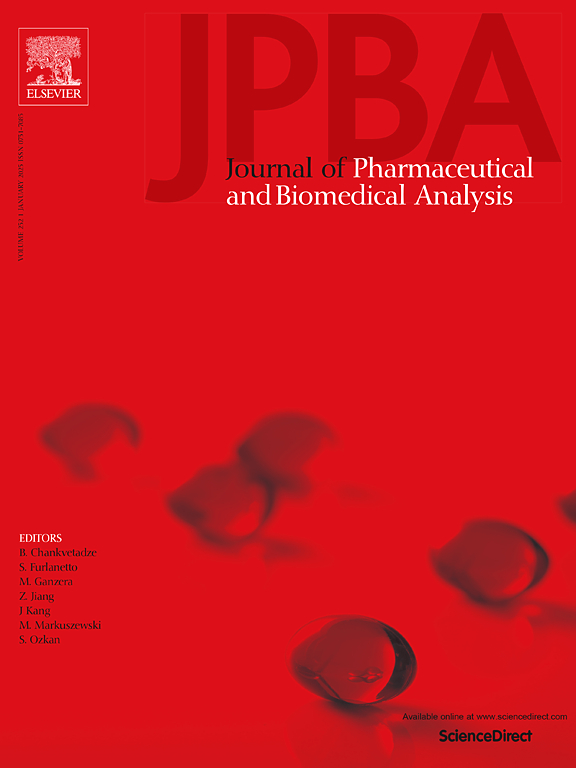The potential mechanism of co-administration of Scutellaria baicalensis Georgi and Rubia cordifolia L ameliorating ulcerative colitis: Integration of metabolomics, network pharmacology, and molecular docking
IF 3.1
3区 医学
Q2 CHEMISTRY, ANALYTICAL
Journal of pharmaceutical and biomedical analysis
Pub Date : 2025-05-05
DOI:10.1016/j.jpba.2025.116948
引用次数: 0
Abstract
Scutellaria baicalensis Georgi (HQ) and Rubia cordifolia L. (QC) are clinically effective against ulcerative colitis (UC), but their synergistic mechanisms remain unclear. This study evaluated the therapeutic effects of HQ, QC, and their combination (HQ-QC) in dextran sulfate sodium (DSS)-induced colitis and explored underlying mechanisms. Mice were divided into normal, model, HQ, QC, HQ-QC, and 5-ASA groups. Colon tissue metabolomics was performed using UPLC-Q-TOF-MS, while network pharmacology and molecular docking identified potential anti-UC targets. The HQ-QC combination significantly alleviated weight loss, colon shortening, and histopathological damage, and improved intestinal barrier function and inflammation compared to single herbs. Metabolomics revealed xanthine, cytosine, and N-octanoylsphingosine-1-phosphate as key metabolites enriched in vascular smooth muscle contraction and fatty acid metabolism pathways. Network pharmacology identified 62 potential targets, with wogonin and xyloidone as major active compounds. KEGG analysis highlighted platelet activation as a key pathway, and molecular docking confirmed strong binding of wogonin and xyloidone to platelet activation-related targets including PIK3CG, NOS3, PTGS1, and MAPK14. These findings suggest HQ-QC exerts synergistic effects in treating DSS-induced UC by regulating vascular smooth muscle contraction and platelet activation, providing mechanistic insight into its clinical potential.
黄芩与芦花联合给药改善溃疡性结肠炎的潜在机制:代谢组学、网络药理学和分子对接的整合
黄芩(Scutellaria baicalensis Georgi, HQ)和芦花(Rubia cordifolia L., QC)对溃疡性结肠炎(UC)有较好的临床疗效,但其协同作用机制尚不清楚。本研究评价HQ、QC及其联合(HQ-QC)治疗葡聚糖硫酸钠(DSS)诱导结肠炎的疗效,并探讨其作用机制。小鼠分为正常组、模型组、HQ组、QC组、HQ-QC组和5-ASA组。结肠组织代谢组学采用UPLC-Q-TOF-MS进行,网络药理学和分子对接鉴定潜在的抗uc靶点。与单一中药相比,HQ-QC联合用药可显著减轻体重减轻、结肠缩短、组织病理损伤,改善肠道屏障功能和炎症。代谢组学显示黄嘌呤、胞嘧啶和n -辛烷鞘醇-1-磷酸是血管平滑肌收缩和脂肪酸代谢途径中富集的关键代谢物。网络药理学鉴定出62个潜在靶点,主要活性化合物为木犀草素和木犀草酮。KEGG分析强调血小板活化是关键途径,分子对接证实了wogonin和xyloidone与血小板活化相关靶点(包括PIK3CG、NOS3、PTGS1和MAPK14)的强结合。这些结果提示HQ-QC通过调节血管平滑肌收缩和血小板活化对dss诱导的UC具有协同作用,为其临床潜力提供了机制认识。
本文章由计算机程序翻译,如有差异,请以英文原文为准。
求助全文
约1分钟内获得全文
求助全文
来源期刊
CiteScore
6.70
自引率
5.90%
发文量
588
审稿时长
37 days
期刊介绍:
This journal is an international medium directed towards the needs of academic, clinical, government and industrial analysis by publishing original research reports and critical reviews on pharmaceutical and biomedical analysis. It covers the interdisciplinary aspects of analysis in the pharmaceutical, biomedical and clinical sciences, including developments in analytical methodology, instrumentation, computation and interpretation. Submissions on novel applications focusing on drug purity and stability studies, pharmacokinetics, therapeutic monitoring, metabolic profiling; drug-related aspects of analytical biochemistry and forensic toxicology; quality assurance in the pharmaceutical industry are also welcome.
Studies from areas of well established and poorly selective methods, such as UV-VIS spectrophotometry (including derivative and multi-wavelength measurements), basic electroanalytical (potentiometric, polarographic and voltammetric) methods, fluorimetry, flow-injection analysis, etc. are accepted for publication in exceptional cases only, if a unique and substantial advantage over presently known systems is demonstrated. The same applies to the assay of simple drug formulations by any kind of methods and the determination of drugs in biological samples based merely on spiked samples. Drug purity/stability studies should contain information on the structure elucidation of the impurities/degradants.

 求助内容:
求助内容: 应助结果提醒方式:
应助结果提醒方式:


